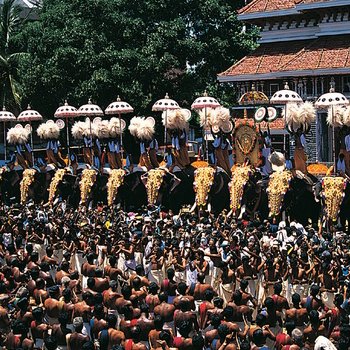Discovering the Sacred Vadakkunnathan Temple: History, Architecture, and Festivals

The renowned Vadakkunnathan Temple is located in the Thrissur district of Kerala. This sacred temple is devoted to Lord Shiva, and it is believed that its establishment was by Parasurama, the sixth incarnation of Lord Vishnu.
The Vadakkunnathan Temple stands as a quintessential representation of Kerala's architectural style. It features monumental towers on all four sides and includes a Kuttambalam. Inside the temple, mural paintings vividly depict various episodes from the Mahabharata. The construction of this illustrious temple occurred during the era of Perumthachan. Historical records suggest Perumthachan lived in the seventh century; hence, it is plausible that the temple is over 1,300 years old. Surrounding this significant structure is the primary venue for the famed Thrissur Pooram festival. It should be noted that entrance to the temple is restricted to Hindus only.This revered temple is protected under the Ancient Monuments and Archaeological Sites and Remains Act. Additionally, both the temple & its remarkable mural paintings have been designated as a National Monument by India.
History of the Temple:
The history of Vadakkumnathan Temple, as described in the Brahmanda Purana and other texts, centres on the legend of its founding by Parashurama. According to this lore, Parashurama requested Varuna, the Lord of the Oceans, to create new land from the sea, which became Kerala. To bless this new land, Parashurama sought the presence of Lord Shiva and travelled to Mount Kailasa to invite him. Shiva, along with his wife Parvati, sons Ganesha and Subrahmanya, and his divine entourage, accompanied Parashurama and halted at what is now Thrissur, where he manifested as a radiant Lingam under a large banyan tree, marking the Sri Moola Sthana—the original site of the deity.
Initially, the lingam remained at the Sri Moola Sthana. Later, the ruler of the Cochin Kingdom decided to move the lingam and build a temple around it. However, the task seemed challenging as removing the banyan tree could potentially harm the lingam. A solution was offered by the Yogatirippadu, who shielded the lingam with his body while the tree was cut down. Remarkably, no branches fell on the lingam, and it was safely moved to the current temple location following sacred rituals. The temple was then constructed according to traditional Shastric guidelines, and the deity continues to be worshipped there today.
Speciality of the Temple
- Unlike the traditional practice of worship in a clockwise direction, devotees here follow an anti-clockwise path.
- The Shiva Linga at the temple is covered with a massive mound of ghee that reaches up to 9 feet in height.
- Another speciality is the daily worship of a mural depicting Vasuki Sayana, where Lord Shiva is shown in a reclining posture. This is notable because, in most temples, murals are not considered objects of worship.
Timings
4 AM to 11 AM
5 PM to 8:20 PM
Festivals in the Temple
- Maha Shivaratri: It is celebrated on the 13th night and 14th day of the Krishna Paksha (waning moon) in the month of Phalguna, typically in February or March.
- Thrissur Pooram: The grand Thrissur Pooram Festival, takes place in the Malayalam month of Medam, usually in April or May.
- Aanayoottu: A unique event where elephants are ceremonially fed, is held annually on the first day of the Malayalam month of Karkidakam, corresponding to July.
Dress Code to Visit the Temple
Traditional attire is preferred when visiting Vadakkunnathan Temple. Men are required to wear a white Pancha or dhoti (mundu) and must remove their shirts before entering the shrine. Women may wear a saree or salwar kameez with a dupatta. Modern clothing such as jeans, shorts, or short skirts is strictly prohibited within the temple premises.
Best Time to Visit
Thrissur Vadakkunnathan Temple can be visited throughout the year. But the best time to visit Vadakkunnathan Temple is during the festivals of Maha Shivaratri (February-March) and Thrissur Pooram (April-May), when the temple is at its most vibrant and lively. For those seeking a quieter experience, the winter months from October to February are ideal, as the weather is cool and comfortable for temple visits and exploring the surrounding areas.
How to Reach the Temple
By Air: Cochin International Airport is the nearest airport to Vadakkunnathan Temple in Thrissur which is situated at a distance of 58.2 Km. Upon arrival at the airport, you can easily reach the temple by taxi or bus.
By Train: : Thrissur Railway Station is the nearest railway station to Vadakkunnathan Temple which is situated at a distance of just 3.7 Km. On reaching the railway station, one can hire a cab, an auto rickshaw or a bus to reach the temple.
By Road: : Vadakkunnathan Temple is conveniently accessible by road. Visitors can reach the temple by private vehicle, bus, or by hiring an auto-rickshaw for a hassle-free journey.
FAQs:
What is the historical significance of Vadakkunnathan Temple?
The Vadakkunnathan Temple, located in Thrissur, Kerala, is believed to have been established by Parasurama, the sixth incarnation of Lord Vishnu. It is a significant spiritual site with over 1,300 years of history.
What unique architectural features does Vadakkunnathan Temple have?
The temple is a classic example of Kerala architecture, featuring monumental towers on all four sides, a Kuttambalam, and vibrant mural paintings depicting scenes from the Mahabharata.
What legends are associated with the establishment of Vadakkunnathan Temple?
According to legend, Parasurama created the land of Kerala by throwing his axe into the sea, aided by Lord Varuna. The temple was established on this newly formed land to honor Lord Shiva.
Which festivals are prominently celebrated at Vadakkunnathan Temple?
Major festivals include Maha Shivaratri, the grand Thrissur Pooram, and Anayoottu (the feeding of elephants), drawing numerous devotees to the temple.
Why is Vadakkunnathan Temple designated as a National Monument?
The temple, along with its exquisite mural paintings, is protected under the Ancient Monuments and Archaeological Sites and Remains Act and is recognized as a National Monument for its cultural and historical importance.